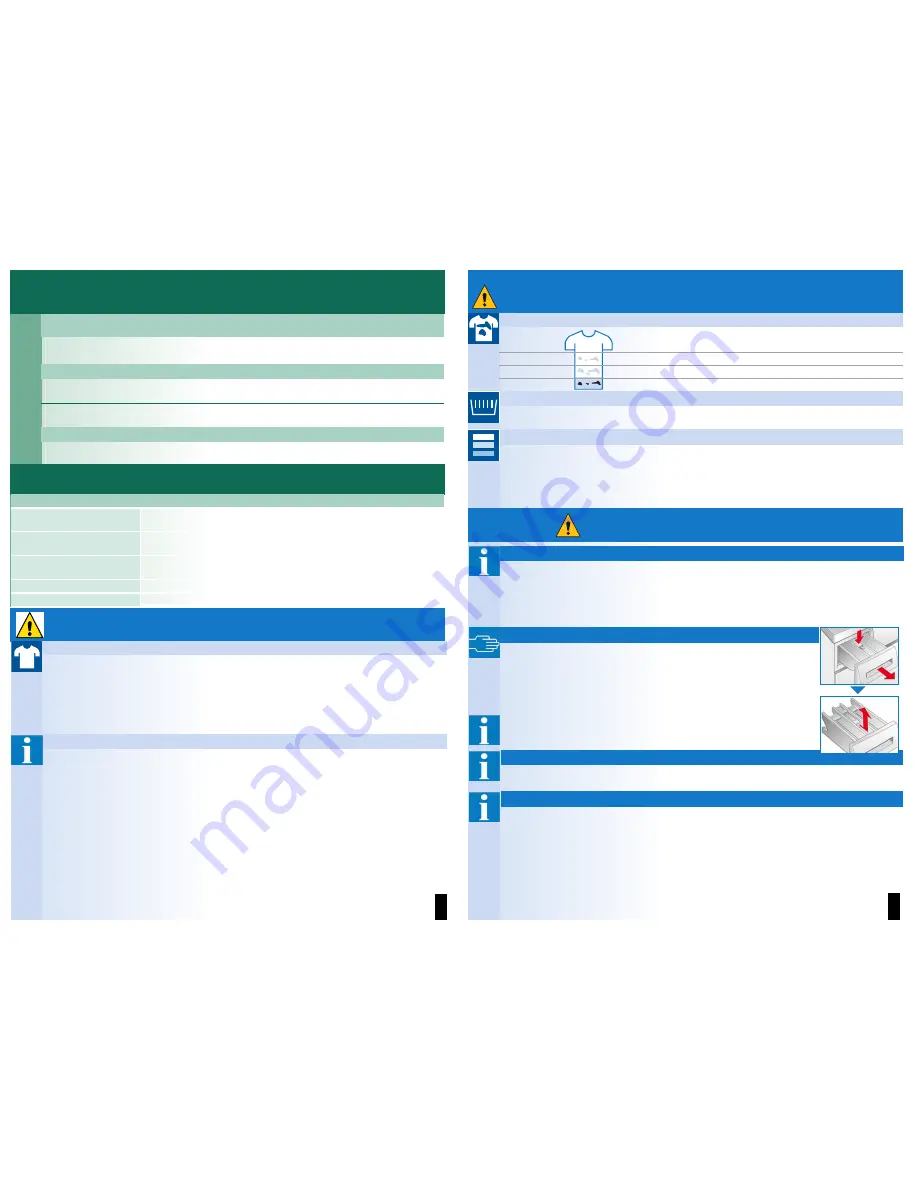
5
6
o
ʋ
ʋ
ʋ
ʋ
ʋ
ʋ
ʋ
ʋ
ʋ
ʋ
ʋ
ʋ
ʋ
o
o
o
~
~
ʋ
ʋ
ʋ
Individual settings
ʑ
Cycle settings for extra cycles
refer also to cycle overview
Refresh
For rinsing unsoiled laundry (e.g. swimwear) and for removing
detergent residue from fabric. Ends with a spin cycle.
ʑ
Additional functions
see also programme overview
Rinse plus
Additional rinse cycle. For areas with very soft water. Also for
improved rinsing.
Quick wash
Reduced wash time
only 2 rinse cycles. Suited for slightly
soiled laundry. Recommended load: up to ½ load.
ʑ
Start
To start or interrupt the cycle.
Important information
Different types of soiled laundry
Wash new items separately.
lightly soiled
Pretreat stains if necessary.
Pretreat stains if necessary.
heavily soiled
Add less laundry. Pretreat stains if necessary.
Starching
Do not use fabric softener in wash
Starching with liquid starch possible in all wash cycles. Add starch in fabric softener dispenser
~c
according to manufacturer's instructions.
Dying/removing color
Dying fabric in the washer is not recommended. Salt in the dye may corrode the stainless
steel components of the washer drum. More than household quantities of dying increase
the risk.
If you choose to use dye in your washer, follow the instructions provided by the dye
manufacturer.
Do not remove color from laundry in the washing machine.
Information to indicator lights
Indicator lights for status displays and/or buttons flash:
Indicator lights
Rinse
and
Wash
flash
Close the washer door properly. Avoid catching laundry items in the
door.
Indicator lights
Spin
and
Rinse
flash
Clean detergent-solution pump (
page 8
), outlet pipe/drainage hose
blocked.
Indicator lights
Spin
and
Wash
flash
Turn on the tap, supply hose kinked/jammed;
clean filter (
page 8
), water pressure too low.
Indicator light
Rinse
flashes
Washer motor failure. Call customer service!
All indicator lights flash
Turn off the tap and call customer service.
Important information
Taking care of laundry and machine
– Empty pockets.
– Check the laundry for any metal objects (such as pens, paper clips, keys, etc.).
– Wash very delicate or small items (like baby socks) in a mesh bag.
– Close zippers, snaps, fasteners.
– Brush sand out of pockets and cuffs.
– Remove curtain sliders or enclose in net bag.
– Remove curtain rings or tie them up in a net bag.
Before washing for the first time
Do not put any laundry in the washer drum! Turn on the tap, fill approx. 1 litre of water and
then pour ½ measuring cup of detergent into dispenser
II
. Set programme selector to
Regular/Cotton Hot
cycle and select
Start
.
At the end of the programme set the programme selector to
Off
.
Care
Machine housing, control panel
– Wipe with a soft, damp cloth.
– Do not use abrasive cloths or sponges. Do not use abrasive cleaners such as stainless steel
cleaner.
– Immediately remove any detergent or agent residue.
– Do not clean the appliance with pressurized water, such as from a water jet or pressure
washer.
Clean the detergent drawer ...
... if it contains detergent or fabric softener residue.
1.
Pull out, depress insert, completely remove.
2. Remove the powder detergent insert.
3. Clean the insert with running water and thoroughly towel dry.
4.
Close and lock the cover (place cylinder on guide pin).
5.
Insert detergent drawer.
Leave the detergent drawer partially open enough that any remaining
residual water will be allowed to dry.
Drum
Leave loading door open so that the drum can dry out.
Rust stains
use chlorine-free cleaning agent, not steel wool.
Descaling
No washing in the machine!
Provided that you use the correct type of detergent, it is not necessary to descale the washing
machine. However if the appliance has to be descaled, pleaqse follow the instructions
provided by the descalling agent manufactuer.
–
Risk of electric shock!
Before beginning any maintenance, unplug
the washer’s electric cord!
–
Risk of explosion!
No solvents!
`


























